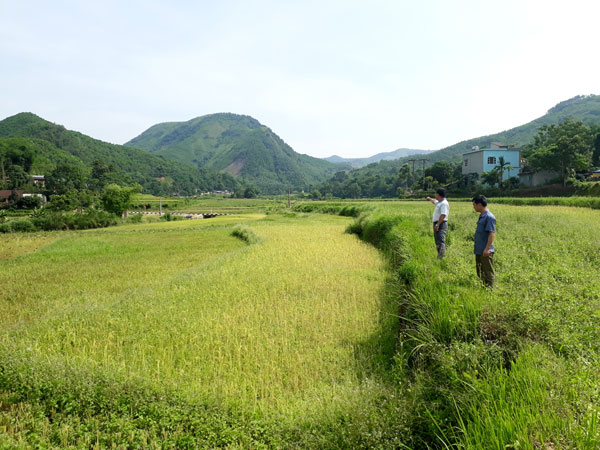
(HBO) – A slow change in the economic structure, along with difficulties in production due to natural disasters, droughts and abnormal fluctuations of the market, have challenged the process of poverty reduction in Lap Chieng commune, Kim Boi district, the northern mountainous province of Hoa Binh.
Lap Chieng has been
received assistance from the government through Programmes 135 which is
designed to help poor communes in ethnic minority-inhabited and mountainous
areas with socio-economic development. The commune is about 10 km from
the centre of Kim Boi district.
Lap Chieng commune comprises three villages,
Lap, Chieng and Khoay, with 438 households. Despite its favorable geographical
location, only 3km from Road 12B and having concreted inter-communal roads, the
transformation of Lap Chieng’s economic structure remains slow, failing to
match its potential. Therefore, the poverty rate in the commune in 2016 was
still high, at 44.8 percent, with the per capita income reaching only 14
million VND per year.
Small
rice fields and droughts have caused difficulties to production in Lap Chieng
commune (Kim Boi district). Photo taken in Chieng village.
By the end of 2016, Lap Chieng had fulfilled 12
criteria of new-style rural area building. Currently, along with the criteria
that require large investment resources, the commune finds it hard to achieve
the criteria in raising local people’s income. Local residents mostly rely on
agriculture without commercial products. The policy of "land mergence and field
exchange” has not been implemented because of a lack of consensus among local
farmers.
According to the Secretary of the commune’s
Party Committee, in 2016, when the price of pork increased sharply, many
households in Lap Chieng invested in expanding pig farms. Therefore, when the
price of pork slumped, local farmers fell into the situation of "double
loss." As a result, this year's target of increasing the per capita income
to 15 million VND per person per year is likely unreachable.
Among the three villages, Khoay village has the
poorest transport system, which hinders the locality to tap its potential in
forestry and bamboo shoot growing.
In Chieng village, fields are filled with different
colours these days. At the beginning of the village, some rice fields are ripe
and are ready for harvesting. Meanwhile, some other fields are still green and
mixed with weeds. Some maize fields are stunned because of exhausted land.
Bui Van Chien, head of Chieng village, said that
farming land in the village is divided into three areas, two of which often
suffer severely droughts. Some fields are left deserted because "there is
no water for farming."
In Dong Me area, many fields are quite large but
do not have enough water for rice cultivation, thus becoming cattle grazing
areas. Some other fields have been cultivated with rice but they have seen more
weeds than paddy. Chieng village has three water reservoirs but the water
volume is still not enough as the water reserve depends on rains.
The Secretary of the commune Party Committee
stressed the need to focus on communications to fulfil the plan of "field
mergence and field exchange”, creating favourable conditions for the
restructuring of the local economy. Alongside, it is important to find crops
and livestock which are suitable to the local conditions, he said, adding that
in the near future, the commune will focus on promoting forest plantation and
cultivation of safe and clean vegetables.
Viet Dao
According to data from the Hoa Binh Provincial Party Committee, the industrial production index for the first six months of 2025 is estimated to have increased by 20% compared to the same period last year. This marks the highest year-on-year growth rate for this period since 2020.
In the first six months of 2025, Hoa Binh province’s export turnover was estimated at 1.145 billion USD, marking an 18.11% increase compared to the same period in 2024. Import turnover was estimated at $ 804 million, a 17.15% increase, which helped the province maintain a positive trade balance.
The lives of the ethnic minority farmers in Tan Lac district have gradually improved thanks to the new directions in agricultural production. This is a testament to the collective strength fostered through the professional associations and groups implemented by various levels of the district’s Farmers’ Union.
With the motto the "product quality comes first,” after nearly one year of establishment and operation, Muong village’s Clean Food Agricultural and Commercial Cooperative, located in Cau Hamlet, Hung Son Commune (Kim Boi district), has launched reputable, high-quality agricultural products to the market that are well-received by consumers. The products such as Muong village’s pork sausage, salt-cured chicken, and salt-cured pork hocks have gradually carved out a place in the market and they are on the path to obtaining the OCOP certification.
In the past, the phrase "bumper harvest, rock-bottom prices" was a familiar refrain for Vietnamese farmers engaged in fragmented, small-scale agriculture. But today, a new spirit is emerging across rural areas of Hoa Binh province - one of collaboration, organisation, and collective economic models that provide a stable foundation for production.
Maintaining growing area codes and packing facility codes in accordance with regulations is a mandatory requirement for agricultural products to be eligible for export. Recently, the Department of Agriculture and Environment of Hoa Binh province has intensified technical supervision of designated farming areas and packing facilities to safeguard the "green passport" that enables its products to access international markets.



